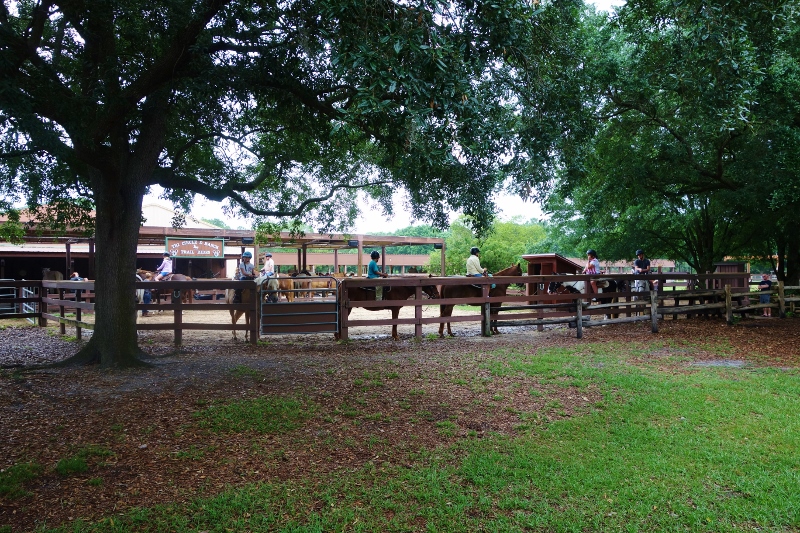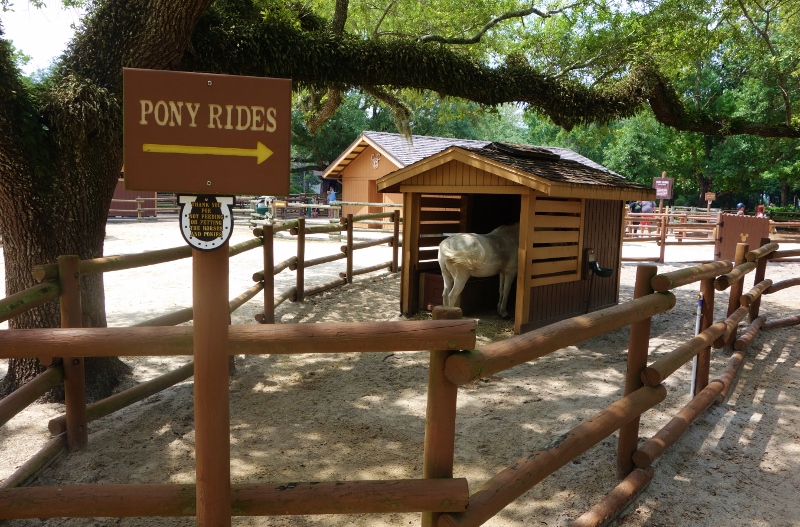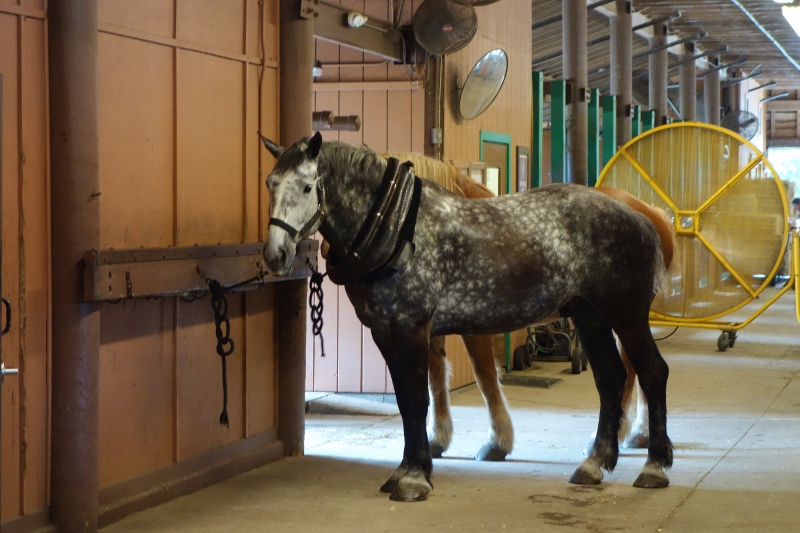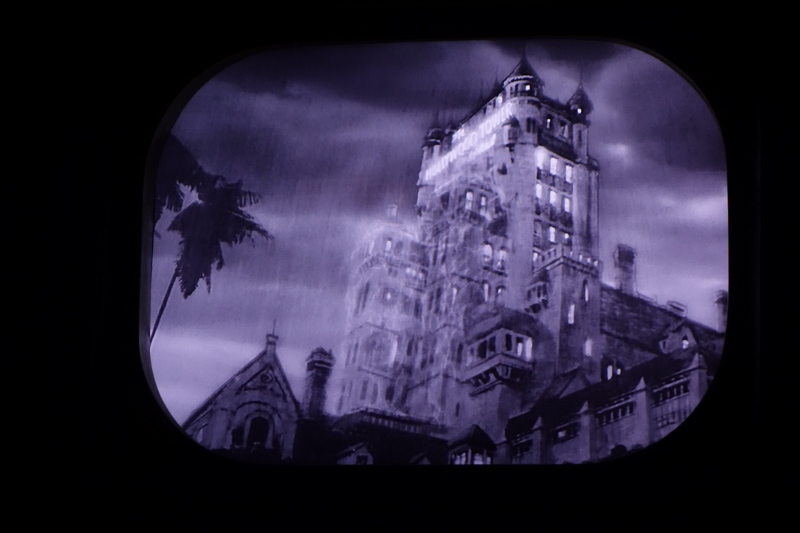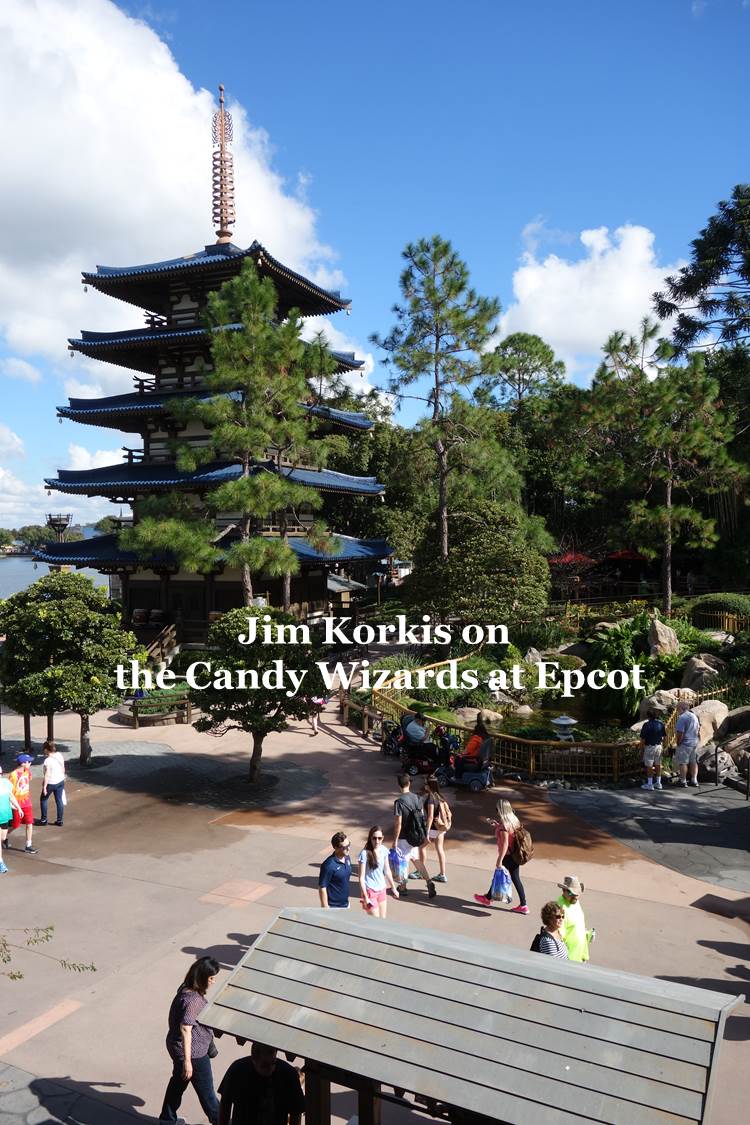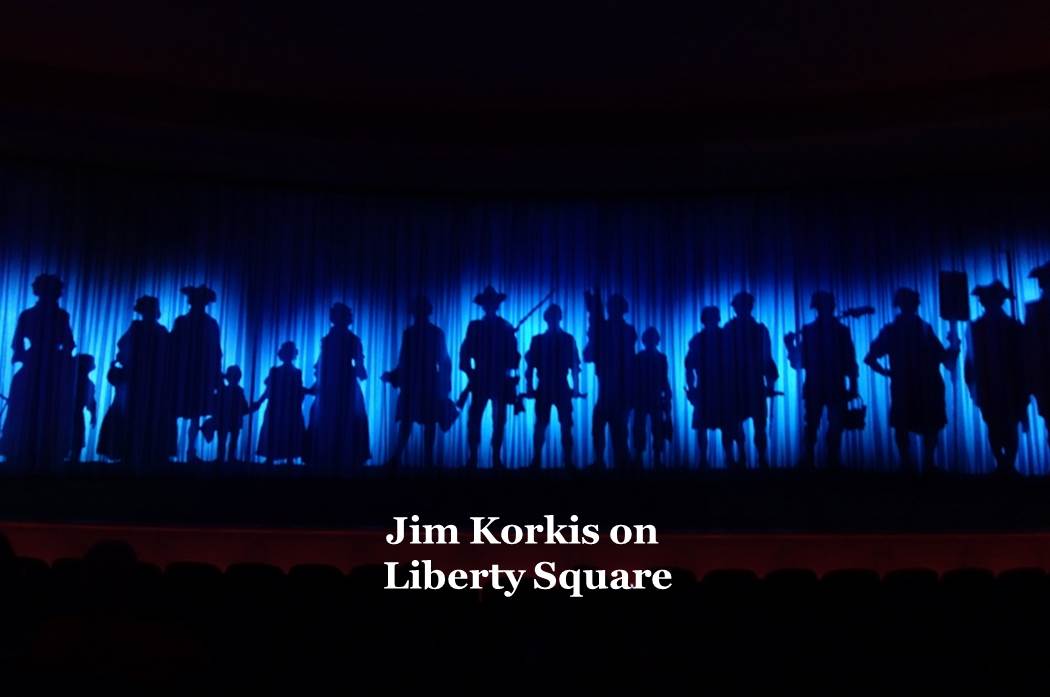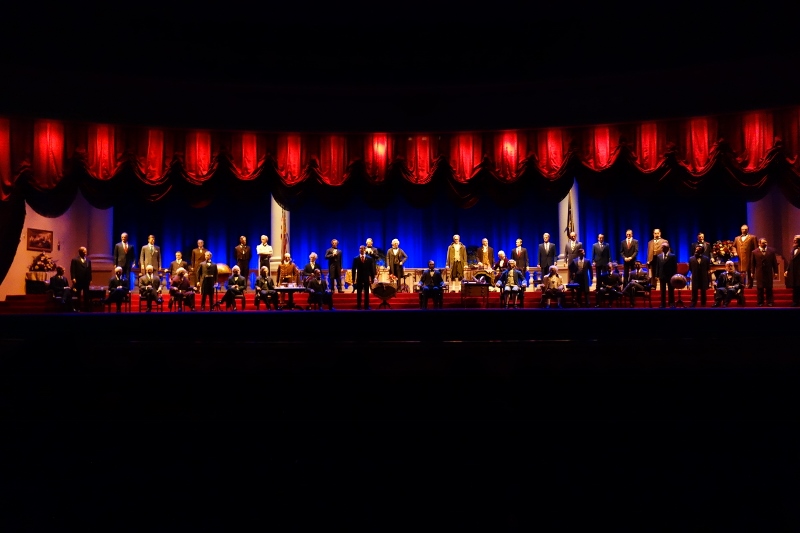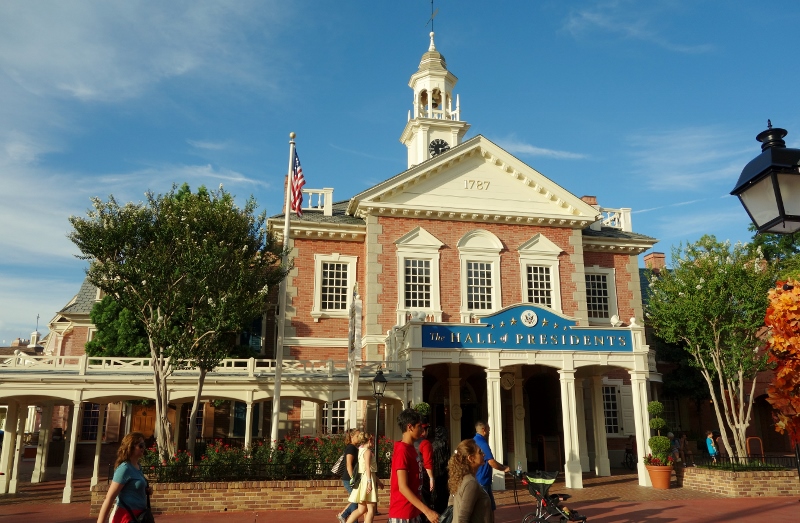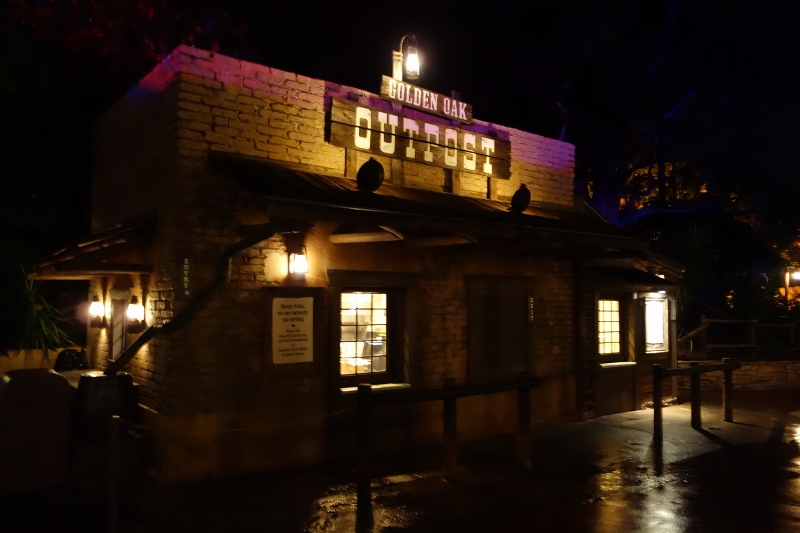Category — A Friday Visit with Jim Korkis
A Friday Visit with Jim Korkis: The Tri-Circle D Ranch
Welcome back to Fridays with Jim Korkis! Jim, the dean of Disney historians and author of Jim’s Gems in The easy Guide, writes about Walt Disney World history every Friday on yourfirstvisit.net.
THE TRI-CIRCLE D RANCH AT DISNEY’S FORT WILDERNESS RESORT & CAMPGROUND
By Jim Korkis
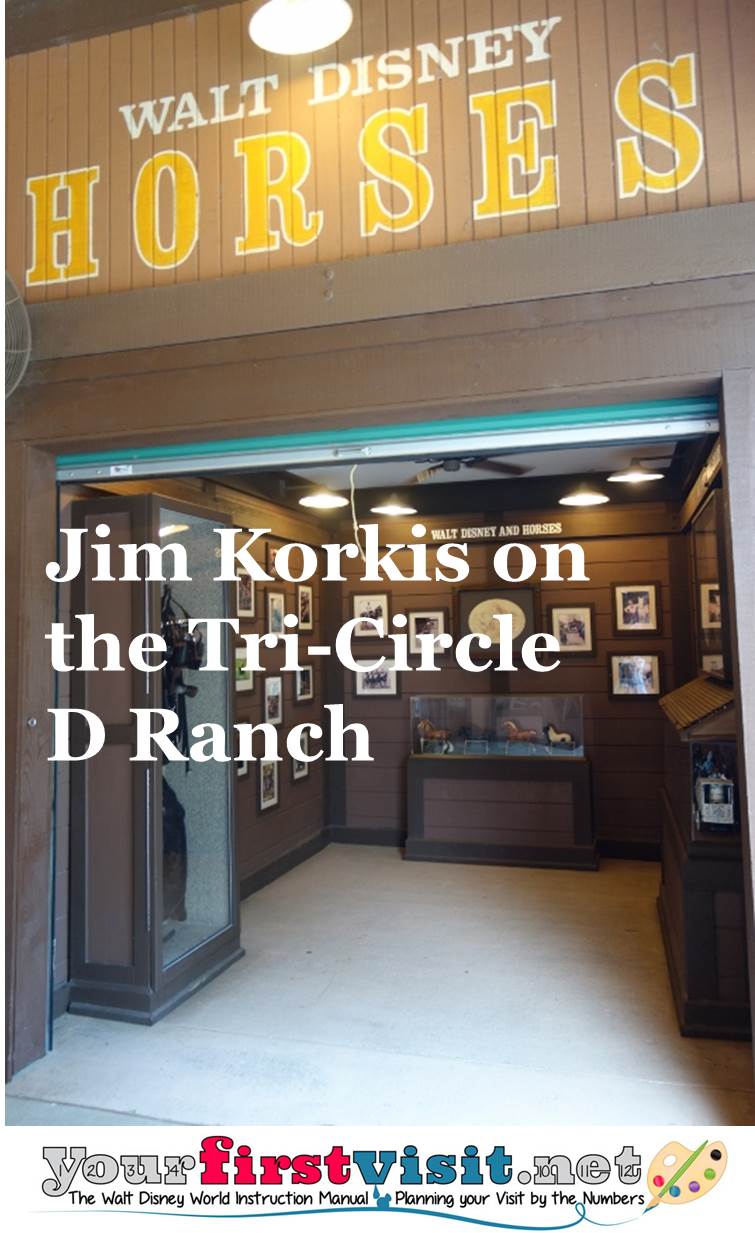
Pope and his wife Dolly lived at Disneyland where they trained and cared for the horses. Their house is still located in the park behind Big Thunder Ranch and will be moved before the building of Star Wars Land there.
It was in this house that Owen made the harnesses and riggings for the horses that would work at Walt Disney World. That’s why his window states “Harness Maker.”
The Popes relocated to Florida in January 1971, where they supervised the creation of the Tri-Circle D Ranch at Fort Wilderness. Tri-Circle refers to the three circles that make the famous Mickey Mouse head silhouette and, of course, “D” stands for “Disney.”
The Popes retired in 1975, but continued to visit at least once a year until their deaths. Owen died in 2000 at the age 96. Dolly died in 2003 at age 89.
The Tri-Circle-D Ranch has two sections that are located roughly a mile apart.
Horseback riding takes place at the Trail Blaze Corral located just inside the main entrance of Disney’s Fort Wilderness Resort and Campground next to the Outpost area. Guests can take the reins for a 45-minute guided trail ride through the resort.
The remaining Tri-Circle-D Ranch areas with the Draft Horse Barn, Blacksmith Shop, Carriage Rides and Pony Rides (the ponies are adults and weigh on average 500 pounds; pony riders have to weigh less than 80 pounds and be under 48 inches tall) are located at the Settlement area, next to Pioneer Hall at the rear of the Campground.
The Draft Horse Barn has a small one room museum named “Walt Disney Horses.” It is a tribute to Walt Disney’s love of horses. It is decorated with photos and memorabilia.
Across from it is the 1907 Dragon Calliope housed under protective glass. Besides being part of the short-lived Mickey Mouse Club Circus parade at Disneyland in 1955, the calliope went on to appear at Disneyland parades until the park’s 25th anniversary. It was then repainted silver and blue and relocated to Florida for the Walt Disney World Tencennial Celebration in 1981 where it remained.
Generally, 80-90 horses are maintained at the ranch and roughly thirty of them are draft horses. The draft horses can get as large as 18 hands tall (72 inches). A hand is about four inches and was originally based on the breadth of a human hand as a measure. They weight approximately 2,000 pounds each.
The horses that pull the Main Street trolleys are fed and bathed in the morning. Around 8 a.m. they are loaded into a trailer and taken to the Magic Kingdom Car Barn where they are put in harness and hooked and ready to go by 9 a.m.
While the trolley is heavy, especially loaded with guests at about 4,000 pounds, it is so well balanced that once it gets moving, it takes only minimal effort to keep it moving. That’s one of the reasons that Disney has started to grease the track just outside the car barn to help it get started.
When Walt Disney World opened, there were four horse drawn trolleys and it cost a dime or an “A” ticket to go one way either up or down the street. Today only one trolley operates, and soon after the 1 p.m. trolley show, it is pulled off the street to avoid congestion because of the parades and crowds.
* * * * *
Thanks, Jim. There’s much more on Fort Wilderness beginning here, and in particular more photos of the Tri-Circle D Ranch here.
Come back next Friday for even more from Jim Korkis!
In the meantime, check out his books, including Secret Stories of Walt Disney World: Things You Never You Never Knew, which reprints much material first written for this site, and The Vault of Walt: Volume 4, and his contributions to The easy Guide to Your First Walt Disney World Visit, all published by Theme Park Press.
Follow yourfirstvisit.net on Facebook or Google+ or Twitter or Pinterest!!
January 22, 2016 No Comments
A Friday Visit with Jim Korkis: The Twilight Zone Tower of Terror
Welcome back to Fridays with Jim Korkis! Jim, the dean of Disney historians and author of Jim’s Gems in The easy Guide, writes about Walt Disney World history every Friday on yourfirstvisit.net.
THE TWILIGHT ZONE TOWER OF TERROR
By Jim Korkis
“One stormy night long ago, five people stepped through the door of an elevator and into a nightmare. That door is opening once again, and this time, it’s opening for you.” — Narration from The Twilight Zone Tower of Terror at Disney’s Hollywood Studios
It was Halloween night, October 31, 1939, when a freakish thunder and lightning storm descended on the Hollywood Hills while the elite of the film community found sanctuary in the prestigious and popular Hollywood Tower Hotel’s elegant lobby. Outside the hotel is a plaque indicating that the hotel was built in 1917.
Among those checking in that night were young singer Carolyn Crosson and her boyfriend Gilbert London as well as a child actress Sally Shine in blond curls and frilly dress (reminiscent of actress Shirley Temple) with her stern governess Emeline Partridge. Sally clutches a Mickey Mouse doll. Over-worked bellman Dewey Todd assisted them into the elevator.
They stepped in, the doors closed, and seconds later the elevator, its passengers, and several sections of the upper stories of the hotel vanished when lightning struck the building, leaving a burnt scar and a gaping hole on the outside.
The hotel is frozen in a limbo of time and space, and while the exterior has fallen into disrepair over the years with overgrown vegetation, the interior remains frighteningly like it was that fateful 1939 Halloween night.
The directory in the lobby is an anagram that spells “evil Tower UR doomed”.
The mahjongg game in the lobby was set up by professional players.
What makes it spooky is that if the players had left the table, they would have pushed their chairs away from the table to get up. Their chairs are in the position as if people were sitting there playing the game… and then just disappeared.
On the wall in the lobby by the concierge’s desk is a “13 Diamond” award. (In actuality the award would only go up to five. Thirteen is an unlucky number.)
That video depicting that horrific evening was directed by Joe Dante, who also directed a segment of the 1983 movie version of The Twilight Zone. The set that they used to film those scenes for the attraction was built in Hollywood for the shooting and then dismantled and reassembled in the lobby of the actual attraction in Florida so it would look exactly as it was in the video.
Imagineers screened each of the 156 episodes of The Twilight Zone television series at least twice. The attraction is littered with references from the show.
Performer Mark Silverman was selected from hundreds of others to provide the voice of Rod Serling by Serling’s widow who made the final selection after listening to him on audio tape.
The design of the building was inspired by the Mission Inn in Riverside, the Biltmore Hotel in Los Angeles and especially the exterior façade of the Chateau Marmont Hotel in Hollywood built in 1927.
The attraction is only 199 feet tall because Federal regulations would have required a flashing red beacon to warn aircraft if it were 200 or more feet tall. It is composed of 1,500 tons of steel, 145,800 cubic feet of concrete, and 27,000 individual roof tiles.
It officially opened July 22, 1994 and quickly became the most popular attraction at the park, later superseded by Toy Story Midway Mania.
“A warm welcome back to those of you who made it, and a friendly word of warning, something you won’t find in any guide book. The next time you check into a deserted hotel on the dark side of Hollywood, make sure you know just what kind of vacancy you’re filling. Or you may find yourself a permanent resident… of the Twilight Zone.”
* * * * *
Thanks, Jim. I’m gonna check with co-author Josh about adding “The next time you check into a deserted hotel on the dark side of Hollywood, make sure you know just what kind of vacancy you’re filling” to the “Where to Stay” section of our guide book!
Come back next Friday for even more from Jim Korkis!
In the meantime, check out his books, including Secret Stories of Walt Disney World: Things You Never You Never Knew, which reprints much material first written for this site, and The Vault of Walt: Volume 4, and his contributions to The easy Guide to Your First Walt Disney World Visit, all published by Theme Park Press.
Follow yourfirstvisit.net on Facebook or Google+ or Twitter or Pinterest!!
January 15, 2016 No Comments
A Friday Visit with Jim Korkis: The Candy Wizards at Epcot
Welcome back to Fridays with Jim Korkis! Jim, the dean of Disney historians and author of Jim’s Gems in The easy Guide, writes about Walt Disney World history every Friday on yourfirstvisit.net.
THE CANDY WIZARDS AT EPCOT
By Jim Korkis
In the days of the Qin Dynasty, nearly 2,400 years ago, the son of a poor Chinese scholar fell in love with a wealthy nobleman’s daughter.
His heart ached for the lovely maid but his head told him he could never marry without money to support an aristocratic bride. Remembering an old pastime his mother practiced, the young man began to toy with bits of rice-flour dough.
With his thoughts focused on his beloved, his hands fashioned ornate sculpture from the dough. Horses, unicorns and fanciful beasts sprang from the mixture.
Soon the youth was attracting crowds of onlookers fascinated by the beautiful wonders he created. In time, the young artist was able to earn his fortune and eventually the hand of the girl he loved.
This is the legend of Amezaiku, a candy art sculpture craft passed on orally from generation to generation through China and Japan. Currently, there are only fifteen people officially trained in the art, which is reminiscent of glass blowing.
Amezaiku, which translates as “sweet candy craft,” is only one of many endangered traditions. It is also sometimes referred to as “zinen houni” or “dream fantasy”.
A rice starch syrup is boiled until it becomes dough-like, malleable and transparent, looking very much like taffy. It is heated to roughly two hundred degrees over charcoal to make it that pliable. Next it is divided into small portions and kneaded and pulled into small balls. During this process, it takes on a pure-white color and often the artist would add a food color like pink, blue or green. The ball is placed on the end of small chopstick.
The artist must then work quickly to form the animal figures at the tip of a chopstick, using tiny candy scissors, tweezers and his fingers. The artist would also use a hand fan to occasionally cool and harden portions. Further decoration and detail is painted on the candy creature with edible dye food colorings.
Animals and insects are common shapes created by Amezaiku to delight younger children.
The Japan pavilion in World Showcase was home to two of the top Amezaiku artists working in the United States.
Masaji Terasawa, a native of Osaka, began working at Epcot in the 1980s. He began as a street performer in Japan and then moved to the Los Angeles area in the early 1970s. At Epcot, he would sometimes perform blindfolded or dance to taped music in slow rhythmic movements similar to traditional Tai Ji Quan.
He is considered a master of the art and trained Shinobu “Shan” Ichiyanagi for three years as his apprentice. Terasawa remains a much in-demand performer at schools, festivals, private parties and other events.
Terasawa said, “I like to show traditional Japanese art with humor and audience participation.”
Miyuki Sugimori first appeared at the pavilion in 1996 and continued working until her final show November 23, 2013. From Tokyo, Miyuki learned the craft starting in 1989 from her grandfather Mr. Kinura, who was a renowned candy artist.
She remains the first and only woman to receive training in Amezaiku in Japan. She has a daughter, Shido, and when asked by a guest if she plans on teaching her daughter this gift, she replied, “no, she cries because her hands hurt” (from the hot temperature).
The “stage” for these candy wizards was a simple cart located outside the front entrance of the Mitsukoshi department store. The cart was equipped with heating elements to keep the candy pliable and also had fans to cool down the finished hot pieces and set the design before it would be handed to guests who had gathered around to watch the performance.
While the artists often sculpted frogs, swans, alligators, tigers, elephants and more, many guests requested winged dragons and unicorns. The candy was edible but many guests tried to preserve the art in a clear plastic bag kept away from heat.
* * * * *
Thanks, Jim. Come back next Friday for even more from Jim Korkis!
In the meantime, check out his books, including Secret Stories of Walt Disney World: Things You Never You Never Knew, which reprints much material first written for this site, and The Vault of Walt: Volume 4, and his contributions to The easy Guide to Your First Walt Disney World Visit, all published by Theme Park Press.
Follow yourfirstvisit.net on Facebook or Google+ or Twitter or Pinterest!!
January 1, 2016 No Comments
A Friday Visit with Jim Korkis: Liberty Square
Welcome back to Fridays with Jim Korkis! Jim, the dean of Disney historians and author of Jim’s Gems in The easy Guide, writes about Walt Disney World history every Friday on yourfirstvisit.net.
LIBERTY SQUARE IN THE MAGIC KINGDOM
By Jim Korkis
Liberty Square is a land unique to Walt Disney World. It exists in no other Disney theme park worldwide and was inspired by plans that Walt Disney himself had for an expansion of Disneyland.
Cobblestones would pave the way down Liberty Street and into Liberty Square, which would be a celebration of Revolutionary War America. All the shops and exhibits would represent the types of enterprises that might be found in Colonial America.
One of the major attractions in this land would be “One Nation Under God”, a 27-minute show. Surrounded by a Circa-rama (later “Circle Vision 360”) screen projecting paintings of significant episodes in U.S. history up to a Civil War climax, the audience would hear off-screen narration of the trials, decisions and formation of the United States, including excerpts from presidential speeches.
At the conclusion, figures of all the nation’s presidents (34 by 1957 when planning started) accompanied by limited electro-mechanical movement and dramatic lighting would be seen on the enormous stage against a rear-projected image of the United States Capitol, as clouds panned across the sky forming an American flag and a rousing musical finale closed the show
“The show was on and off at various times in the Studio, but when it came time to really firm it up for Florida, when I dug out the original script, it dated back to 1961. And the Hall of Presidents was very much Walt’s baby. He had this great desire to present to an audience all of the Presidents of the United States on stage at once. He read into that single idea a feeling that it would have great impact and great audience interest and fascination, and, in truth, it does,” said James Algar, who wrote the original script for the attraction as well as for Great Moments with Mr. Lincoln.
The Hall of Presidents features all the presidents from George Washington to Barack Obama, all sculpted (except for Obama) by Disney Legend Blaine Gibson from photos and paintings.
Great attention to detail was taken even in the wardrobe to match the material used during those time periods. If a guest were to lift the pant legs of Franklin Roosevelt, they would see he was wearing polio braces just like he wore in real life.
The facade of the original Hall of Presidents in 1971 was flat brick with three windows directly above three doors into the waiting area. It wasn’t until 1973 that the white veranda and breezeway were added. The date of 1787 on the front of the building refers to the year the Constitution was signed, since the focus of the original show was the Constitution and the American Presidency.
With the creation of Walt Disney World, the Disney Imagineers decided to make Walt’s dream become a reality and use the new land as a preface to the story of Frontierland that recounted the expansion of America.
The decision to build this new land was also reinforced by the fact that America’s Bicentennial was just a few years away. When Walt Disney World opened in 1971, Liberty Square proved to be the most popular area of the new Magic Kingdom.
One of the most remarkable things about Liberty Square is that it is probably the one land at the Magic Kingdom that has had the fewest significant changes over the last 40 years. Other than some cosmetic changes like moving the flags from the bridge to surrounding the Liberty Bell, a guest visiting Liberty Square today would experience much the same as a guest in 1971.
* * * * *
Thanks, Jim. Come back next Friday for even more from Jim Korkis! There’s more on Liberty Square and Frontierland here.
In the meantime, check out his books, including Secret Stories of Walt Disney World: Things You Never You Never Knew, which reprints much material first written for this site, and The Vault of Walt: Volume 4, and his contributions to The easy Guide to Your First Walt Disney World Visit, all published by Theme Park Press.
Follow yourfirstvisit.net on Facebook or Google+ or Twitter or Pinterest!!
December 27, 2015 No Comments
A Friday Visit with Jim Korkis: French Fries in Frontierland
Welcome back to Fridays with Jim Korkis! Jim, the dean of Disney historians and author of Jim’s Gems in The easy Guide, writes about Walt Disney World history every Friday on yourfirstvisit.net.
MCDONALD’S FRENCH FRIES IN FRONTIERLAND
By Jim Korkis
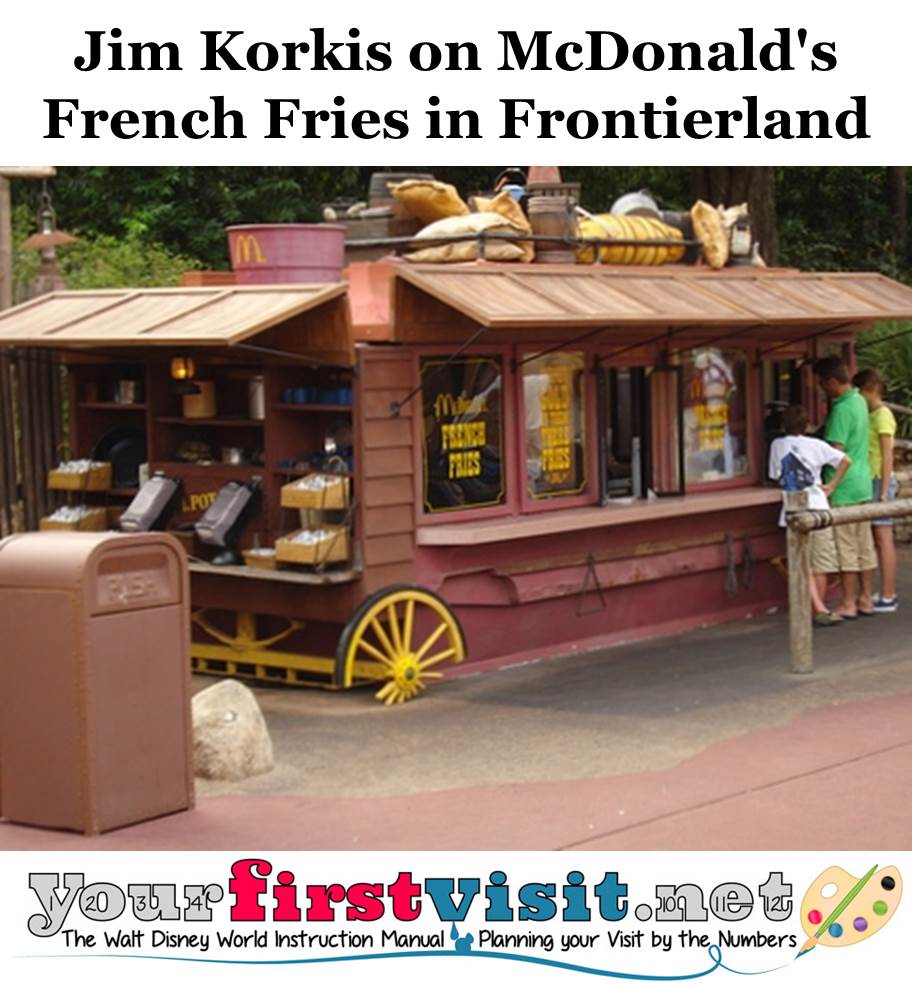
“Dear Walt, I feel somewhat presumptuous addressing you in this way yet I feel sure you would not want me to address you any other way. My name is Ray A. Kroc….I look over the Company A picture we had taken at Sound Beach, Conn., many times and recall a lot of pleasant memories…I have very recently taken over the national franchise of the McDonald’s system. I would like to inquire if there may be an opportunity for a McDonald’s in your Disneyland Development.”
A young Walt Disney was assigned to the American Red Cross Ambulance Corps unit training in Sound Beach in 1918 and eventually went to France even after the Armistice officially ended World War I. Kroc was also in that unit but did not go to France.
Walt responded with a warm letter informing Kroc that his request had been sent to C.V. Wood, who was in charge of Disneyland concessions, because things were too hectic at the moment for him to handle it personally. Kroc claimed he never received a response from Wood.
McDonald’s did get a presence in Disney theme parks due to an agreement with Disney from 1997 to 2007.
The McDonald’s Fry Cart that opened in 1999 was located near Pecos Bill Tall Tale Inn and Café and sold its famous French fries and soft drinks. Disney Imagineers wrote the following back story for that location:
With the rush of prospectors passing through Frontierland in search of gold, lots of folks in town started looking for ways to cash in on all the excitement. Back in 1853, ol’ McDonald (who had a farm, “ei-ei-o”), a potato farmer, decided to set up his cook wagon on the hill under the big oak tree, just off the main trail.
To drum up interest in his French fried delicacies, McDonald even came up with a catch phrase and posted it on the front of the wagon: “There’s gold in them thar fries!” (with a symbol of a golden arch to emphasize the fact).
Business was booming for a couple of good years, right up until the great flood of 1855. Legend has it that white men disturbed the spirits of the mountain by removing gold from Big Thunder, causing all sorts of havoc from earthquakes and avalanches to storms and floods.
In fact, the nearby river rose so much, the water reached right up to McDonald’s wagon on the hill. The wagon survived, but when the water receded, the wagon started to go with it. It slid down the hill, crashed through a fence (and sharp-eyed guests could see the poorly repaired fence), and got lodged in the mud down below.
This didn’t stop ol’ man McDonald, though. He just laid down some planks so folks wouldn’t get their boots muddy, and he has kept right on selling his delicious French fried potatoes until the Disney agreement ended.
There was also a sign placed nearby that proclaimed, “Same location since ’53.” The “53” was scratched out and painted over with a “55.” Not only did this help support the story that the wagon had moved, it was also a reference to McDonald’s history.
Brothers Dick and Mac McDonald opened their original restaurant in San Bernardino, California, in 1953. Kroc, who pitched the idea to the brothers of expanding their restaurant into a franchise, opened his first location in Des Plaines, Illinois in 1955.
The Frontierland Fry Cart closed in December 2007.
The Golden Oak Outpost opened in the same location on January 11, 2009. The name is a tribute to Disney’s Golden Oak Ranch in California, an 800-acre movie ranch where Disney filmed a great many live-action television shows and films.
* * * * *
Thanks, Jim. And come back next Friday for even more from Jim Korkis!
In the meantime, check out his books, including Secret Stories of Walt Disney World: Things You Never You Never Knew, which reprints much material first written for this site, and The Vault of Walt: Volume 4, and his contributions to The easy Guide to Your First Walt Disney World Visit, all published by Theme Park Press.
Follow yourfirstvisit.net on Facebook or Google+ or Twitter or Pinterest!!
December 18, 2015 No Comments
A Friday Visit with Jim Korkis: Forgotten WDW Holiday Traditions
Welcome back to Fridays with Jim Korkis! Jim, the dean of Disney historians and author of Jim’s Gems in The easy Guide, writes about Walt Disney World history every Friday on yourfirstvisit.net.
FORGOTTEN DISNEY WORLD HOLIDAY TRADITIONS
By Jim Korkis
At one time, Walt Disney had several holiday traditions that were unique to the Florida resort, including the Jolly Holidays Dinner Show and The Glory and the Pageantry of Christmas show.

“Those Jolly, Jolly, Jolly Holidays! Those Holly, Holly, Holly Jolly Days! All the decorations! Many celebrations! Many happy faces! Cozy fireplaces! Let the bells ring out now! Everyone sing out now!”
The Jolly Holidays Dinner Show at Disney’s Contemporary Resort was performed from 1992 through the 1998 Christmas season when it was discontinued. The Fantasia Ballroom in the resort’s convention center was converted into an immersive theater-in-the-round setting with more than a hundred talented performers in a musical extravaganza. Besides the raised main stage, there were several smaller stages on the outer perimeter of the tables.
Performers spilled out into the audience, as well. The show took place at “Holiday Village” where the patriarch of the town known simply as “Papa” (and looking a bit like a grey-bearded Sebastian Cabot with a deep gravely voice) recalled his memories of the holidays.
Mickey, Minnie, Pluto, Goofy and Chip ’n’ Dale cavorted with perky singers and dancers. The Country Bears dropped by to play a tune before they went back out into the snow to play. There was even a short version of the Nutcracker Suite featuring the hippos and ostriches from Fantasia. Some scenes seemed to be borrowed from other shows including the tap dancing horses for the sleigh ride, the marching toy soldiers and Santa Goofy making an appearance.
In addition, guests enjoyed an all-you-can-eat feast of fresh-cooked turkey, honey-baked ham and other holiday treats. It was a hugely popular show, often completely sold out even at a premium price, although significant changes were made in its final year that did not please everyone.
For more than fifteen years in the 1980s and 1990s, the Disney Village Marketplace (now known as Disney Springs) ushered in the season with another holiday gem, a performance of The Glory and the Pageantry of Christmas.
It was literally a traditional “living nativity scene” enactment that was originally performed at the open air pavilion known as the Captain’s Tower (now Pin Traders) but soon moved to the larger venue of the Waterfront Dock Stage. The shopping area nearby was decorated to suggest a recreation of the little town of Bethlehem.
It was such a popular and dignified show that guests did not mind standing in line for hours for a chance to see it. “The Christmas Story”, narrated by Kevin Miles (whose deep baritone voice could also be heard in venues like Epcot’s Voices of Liberty and Magic Kingdom’s Dapper Dans) and interspersed with Christmas songs, was amazingly simple.
Mary and Joseph approach the manger and she reveals a child wrapped in swaddling clothes. The shepherds appear. The angels appear, rising up from behind the manger. There was a total cast of 36 performers.
The narration told how the shopkeepers of the village brought gifts including cheese from the dairyman and breads from the baker. Sadly, one little orphan child had no gift to bring. To the strains of the song “Little Drummer Boy,” a small child walks up to the manger and encouraged by Mary, plays his drum.
There was no official announcement of the reason for the show’s cancellation although many suspected that it was Disney’s attempt to remove any specific religious connotation surrounding the holiday, but there were rumors that it had grown so popular that large audiences caused logistical challenges. There were also grumblings that the show was not substantially increasing sales at the nearby shops.
* * * * *
Thanks, Jim. And come back next Friday for even more from Jim Korkis!
In the meantime, check out his books, including Secret Stories of Walt Disney World: Things You Never You Never Knew, which reprints much material first written for this site, and The Vault of Walt: Volume 4, and his contributions to The easy Guide to Your First Walt Disney World Visit, all published by Theme Park Press.
Follow yourfirstvisit.net on Facebook or Google+ or Twitter or Pinterest!!
December 11, 2015 No Comments

